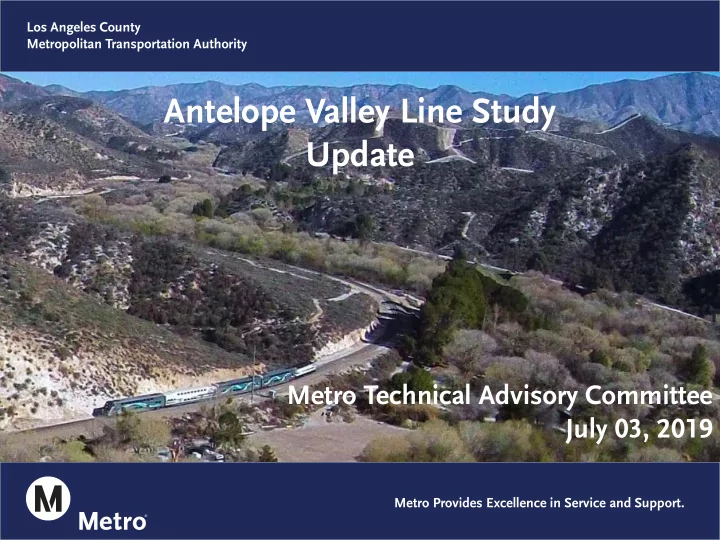

Los Angeles County Metropolitan Transportation Authority Antelope Valley Line Study Update Metro Technical Advisory Committee July 03, 2019 Metro Provides Excellence in Service and Support.
AVL Study Context 1. Strong Ridership and Mode Share Growth a) Daily AVL trips could increase from 6,500 in FY19 to 15,000 by FY30 b) Projected 9% growth per annum through 2042 Station FY15 FY19 2042 Growth Trends GLENDALE 609 718 1,568 BURBANK 832 925 1,689 BURBANK AIRPORT-NORTH — 79 727 SUN VALLEY 76 102 899 SYLMAR / SAN FERNANDO 462 642 4,598 NEWHALL 295 394 1,942 SANTA CLARITA 263 401 1,566 VIA PRINCESSA / VISTA CANYON 421 546 944 ACTON / VINCENT GRADE 95 130 425 PALMDALE 342 499 8,241 LANCASTER 349 475 4,295 2 3,744 4,911 39,025 TOTAL
Existing AVL Stopping Patterns Existing net cost to operate and maintain the Antelope Valley Line is $34.5 million with 15 daily round trips using 6 train sets and AVTA bus support. 3
Service Scenario Plan 1. Study identified a phased incremental plan for improving AVL service, if funding is identified. a) Planning years provided are build out conditions due to multiple service options and capital project scheduling. b) New/Available round trips can be filled by current operators (Metrolink or Union Pacific Railroad) or future potential operators (Amtrak –Pacific Surfliner, California High Speed Rail Authority or Virgin Trains USA) 4
Service Scenario Plan Five Year Plan Scenario 1: 1 additional late evening train Ten Year Plan Scenario 2: 2 additional off-peak round trips to provide hourly mid-day service Twenty Year Plan Scenario 3: Improved peak service and semi-hourly off-peak service Future Year Plan Options Scenario 4: Semi-hourly service plus express service Scenario 5: Same as (4), with intermediate turns at Santa Clarita Scenario 6: Same as (4), with intermediate turns at Sylmar/San Fernando 1. Collectively, the 6 service scenarios will require 14 capital projects. 2. Antelope Valley Line Stakeholders advised the team to move 5 forward with service scenarios 1, 2 and 3
Scenario Infrastructure Project Overview 1. Lancaster Terminal Improvements 2. Palmdale North Double Track 1 3. Acton Siding Extension 4. Ravenna South Siding 5. Via Princessa - Honby Siding Extension 6. Canyon-Santa Clarita Siding Extension 2 7. Hood-Saugus Double Track 8. Balboa Double Track Extension 9. Sylmar to Roxford Double Track 6 10. Sylmar Station Improvements 7 11. Van Nuys Blvd to Sylmar Double Track 12. Sheldon-Van Nuys Blvd. Double Track 3 13. McGinley to Sheldon SOGR 5 4 Santa 14. Brighton-McGinley Double Track 10 8 12 9 11 14 13 Scenarios 1, 2 and 3 require 4 of 14 capital projects highlighted above. 6
Capital Project Investments for Scenarios 1, 2 & 3 First Phase to support Service Scenario 2 1. Balboa Double Track Extension-Balboa 2 Boulevard to Sierra Highway; Capital Cost = $41.8M Second Phase to support Service Scenario 3 2. Lancaster Terminal Improvements, Cost = $27.3M 3. Canyon-Santa Clarita Siding, Cost = $48.8M 4. Brighton-McGinley Double Track, Cost = $57.3M Track Comparison 3 1 4 First phase capital investment allows for hourly mid-day service and existing peak service 7 Second phase capital investment allows for 30 minute bi-directional service to Santa Clarita and hourly service from Santa Clarita to Lancaster.
Funding Opportunities 1. Local funding has not yet been identified for the capital infrastructure required to achieve the twenty year plan, Total Cost: $175.2 M a) Phase I, First Ten Years: $41.8 M, Team to work with State and Local Partners to identify funding. b) Phase II, Second Ten Years: $133.4M, Team to work with Local, State and Federal Partners to identify funding. 8
Future Passenger Service with multiple Operators A. Potential New Operator Along the Corridor 1. The State is considering an extension of intercity passenger rail service to Santa Clarita to connect with the Pacific Surfliner service in Los Angeles. This could present an opportunity for through service between Santa Clarita and San Diego with Amtrak bus service to shorten the commute to Bakersfield from the current 3 hours to about 90 minutes(LAUS to Bakersfield). Amtrak Bus Service *This exhibit modified the Vista Canyon Station 2018 State Rail Plan Intercity Rail New investment opportunity would require coordination between 9 LOSSAN and Metrolink
Future Passenger Service with multiple Operators HSR Blended Service/ Blended Operations: 1. Current Limitations on HSR between Palmdale and Los Angeles a) Original HSR Plan for dedicated alignment extremely costly; funding unlikely b) Blended service on the AVL route offers potential benefits for CHSRA, Virgin Trains USA, Amtrak and Metrolink rail services 2. Further analysis required for additional capital investment a) Identify line electrification constraints for CHSRA such as vertical clearance and curve straightening projects. b) Identify and evaluate additional capacity projects to support blended service 10 10 Source: 2018 State Rail Plan- 2040 So Cal Vision
Future Passenger Service with multiple Operators 1. Rail Multiple Unit Technology – Rail Multiple Units a) Diesel Multiple Unit (DMU) – One Power Car required for four cab cars b) Electric Multiple Unit (EMU, similar to HSR) – 1:3 ratio for powering c) Metrolink is developing a Fleet Modernization Plan (Fall 2020) to plan for a zero emissions future. 2. Travel Time Improvement a) 100 mph maximum capability for both (79 mph CA max speed) b) Tilting train capability for both DMU and EMU 3. Compatibility with Future High Speed Rail Source: Redlands Passenger Rail Project (SBCTA) Continue to evaluate the extent to which the EMU service supports future development of HSR in the corridor 11 11
Thank You! 12 12
Recommend
More recommend